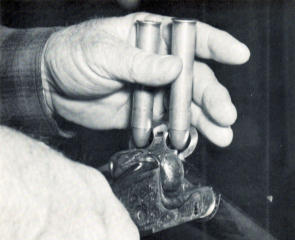23 August 2012, 23:53
KathiZambia:81 buffaloes die in stampede/UPDATE
http://allafrica.com/stories/201208231113.htmlZambia: 81 Buffaloes Die in Stampede
23 August 2012
ABOUT 81 buffaloes have died in a stampede in the Kafue National Park in Itezhi-Tezhi District in Central Province.
The buffaloes were discovered dead by wildlife police officers on patrol along Musa Stream in the southern part of the park on August 20, 2012.
This is according to Itezhi-Tezhi District Commissioner, Roy Nang'alelwa, who confirmed in an interview yesterday.
"About 81 buffaloes were found dead in Musa Stream in Kafue National Park in Itezhi-Tezhi and Zambia Wildlife Authority (ZAWA) has dispatched officers to the area to investigate the cause of the stampede," he said.
Mr Nang'alelwa said the buffaloes were found dead with most of them floating in the stream.
He said the Authority had also launched extensive patrols in the area to prevent further loss of animals.
ZAWA has since dispatched its officers to collect the carcasses for distribution to all departments in the district.
And Itezhi-Tezhi District veterinary expert, Shepherd Phiri, has also rushed to the area to investigate and establish the actual cause of death of the wild beasts.
In September, 2009, ZAWA lost 35 buffaloes worth about K272 million.
The deaths were caused by lions that were chasing the buffaloes.
03 September 2012, 19:41
KathiWhen Itezhi-tezhi partied with buffaloes
September 3, 2012
By KELVIN KACHINGWE
THERE was a huge party in Itezhi-tezhi. The menu was 98 buffaloes. Those partying involved fishermen, government departmental heads, villagers, crocodiles, vultures and wild dogs among others.
On average, a baby buffalo is estimated to weigh around 50 pounds, a female adult at 1,000 and a male adult at 2,000. Calculate approximately how much meat was available for the inhabitants of Ithezi-thezi.
The chairman of a fishing group at a camp that is popularly called Bagdad, Chris Kawanga, arrived at Musa river around 05:00 hours, only to be greeted by the sight of close to a 100 buffaloes floating on water. No one really knows what led to the deaths although general agreement is that they were being chased by 20 lions that are believed to be in the area leading to a stampede.
There is a joke that a herd of buffalo can only move as fast as the slowest buffalo, and when the herd is hunted, it is the slowest and weakest ones at the back that are killed first.
Anyhow, a sober conclusion of what time the buffaloes died, in what is largely believed to be a stampede is not known. But certainly, it was in the night.
The reason is simple.
Lions tend to hunt mostly by night or in the early mornings, and for much of the rest of the time are the embodiments of lassitude. However, being opportunists, they will hunt whenever the chance arises and that could even be in the middle of the hottest day. Of some significance here is the fact that they are not very fast animals, while by contrast, the animals they hunt are some of the fastest on the planet.
In the Ithezi-thezi case though, the Zambia Wildlife Authority (ZAWA) officers were not the fastest to arrive at the scene where the buffaloes died. They arrived at the confluence of Musa and Luwangandu rivers around 10:00 hours, which is six hours after Mr Kawanga first saw the buffaloes floating on water.
Anyhow, Edward Chilufya, the ZAWA area warden for Ngoma in the Kafue National Park, has a rough idea of what happened. For a start, he does not see anything strange with the death of so many buffaloes, which his office has officially put at 80.
He believes there were close to 1,000 were being chased by lions, and then decided to cross the river. But like is the case in stampedes involving people, the same could have probably happened with buffaloes pushing each other. And with the confluence being steep, it is no brainer that so many buffaloes died.
“The same thing happened in 2009, but in that instance, the casualties were less, probably we have such cases happening every now and then involving one or two animals. We suspect that the incident must have happened in the night as usually lions hunt in the night. The fishermen found the carcases floating early in the morning.
“At first they thought it was a bunch of hippos, but it was actually buffaloes. The incident is not strange because we think it was an ordinary scare from the lions, and unfortunately, they found themselves on the steep of the river…and we can’t say there are too many lions in the park although there has been a significant increase in the past few years,” he explained to a team of Zambia Daily Mail reporters who had rushed to the area when news broke out about the death of the buffaloes.
The stampede happened on a Monday, and by Thursday morning, only one buffalo was found floating at the scene. Upon return from the scene and being told that only one buffalo was found on water, Chilufya was not that much surprised.
“There were too many interested parties, yesterday [Wednesday] when we went there with the guys from ZNBC, there were a number of them still floating on water,” he said.
Indeed there were a number of interested parties!
This writer and his colleague, Brian Malama, did not even get to taste the buffalo meat despite being in the area for two days and two nights. If you were to put a reason to that, it was due to some outstanding greed. Again, not entirely surprising!
Buffalo meat is one of the leanest, healthiest types of meat available, as most of the fat is on the outside. While beef contains fat throughout, buffalo is almost completely fat-free. The fat on outer portions can be easily trimmed away and discarded. It is no wonder why this exceptionally lean meat is preferred by those who are trying to eat healthier and cut fat from their diets. Besides the amazing health benefits, it is easy to prepare, and it tastes absolutely delicious.
One local reported that one senior official loaded three buffaloes on a vehicle with the initial idea of distributing the meat among departmental heads. However, upon reaching town, he changed his mind saying the departmental heads should have organised their own transport.
This is the man who was having difficulties closing the door to his freezer.
But he was only one of the many players.
The crocodiles were obviously having a festivity time. Despite the threat of crocodiles on the river, people were still willing to risk all for a share of the buffaloes.
Crocodiles are known for staying near the water’s edge or at the surface and trying to grab anything that moves into the water to eat. If it is too big, they will try to drown the prey first and then tear off pieces of it by spinning their body around.
However, that is a risk people were willing to live with.
They would go with the boats on the river and then start pulling the carcass to the shore. They claimed that the buffaloes were a bit lighter because of the time they spent on water.
“Of course we were scared of the crocodiles. I think the crocodiles ate more buffaloes than the people,” Ernest Kalimbu, a fisherman of Sisiteje, who was found at Baghdad fishing camp, said.
Somebody else added. “Even at night [Monday night], people especially these departmental heads were still here, making calls to others to come and get some meat, it was a lot, between 90 and 100. I have a bit, but how to hide it and take to Lusaka is the problem,” somebody based in the park doing some construction works but originally from Lusaka, said His fears were genuine.
On the way back, the Daily Mail witnessed a truck being impounded by Zawa officers after finding some game hidden on it. Obviously, the instructions were clear – no game meat should be allowed to leave Itezhi-tezhi.
Fine, but atleast share.
“We were just given a bit by the ZAWA officers, they are the ones who got most of it, when our chairman discovered the buffaloes, we immediately called them, we can prepare some nshima for you with fish if you can wait for those that have gone fishing to come back,” one of the fishermen, who took the Daily Mail team to the scene explained.
It is not like the locals and even ZAWA officers had waited for the health personnel to certify the meat fit for consumption.
“Normally, we don’t allow food that has died on its own to be consumed by human beings. But you know, as usual, it is very difficult to control human beings. By the time we were getting there, they had already started eating the meat, it is not documented, but the buffaloes may have some zoonotic diseases which they can pass on to humans, fortunately, we found nothing in the buffaloes that died,” Dr Shepherd Phiri, the Itezhi-tezhi district veterinary officer, said.
Zoonotic diseases or not; Itezhi-tezhi would probably welcome another buffalo stampede!

 ..
..